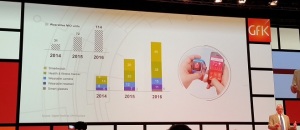
Insights + interviews
GfK At IFA: Consumer Electronics And Domestic Appliances
The Active Age recently attended the IFA Global Press Conference 2015; here are some upcoming trends to look forward to in terms of consumer electronics and domestic appliances.
Speakers from GfK:
Jurgen Boyny, Global Director Consumer Electronics
Gerard Tan, Director APAC, Digital World
Friedemann Stockle, Global Director MDA and Automotive
Udo Jansen, Global Director Small Domestic Appliances
Despite the number of international political and financial situations taking place, GfK is seeing an increase in personal consumer spending; most notably on personal items such as automobiles, consumer electronics, housing and renovation.
Digital appliances such as televisions and home audio are also playing a part in the spending on housing. Innovative features such as internet connectivity, 4K content, better screen displays and connected audio functions across consumer electronics are generally appreciated by consumers. Consumers are purchasing more of such smart devices across Europe, when comparing figures from 2010 to 2014.
GfK numbers also show that mobile internet devices sales are increasing around the world. In Asia Pacific, over 64% of spending was on consumer electronics, this is being driven by a want for devices that can be connected to the internet. Asia is however experiencing a slowdown in consumer electronics spending, due to an increase in telecommunication hardware saturation levels, due to the impact of tablets in competition with standard form factor PCs as well as the increase in number of brands offering similar products. Smartphones are also eroding the sales of other devices such as cameras and music players.
Network music systems have increased in market share – 2008 to present.
Consumers own music content on their personal mobile devices and they want to access good audio quality at home. They are also starting to stream content and thus audio devices used to listen to such content need to have internet connectivity as a base-level function and for control through a smartphone application.
TVs are becoming a commodity.
Competition on price heats up, as brick and mortar retailers continue to face challenges from online stores. Consumers can look forward to better prices or better value added items when they compare and shop between online and offline stores.
There are more screens in the Asian home.
Despite the increase in competitor brands offering similar products, most homes will own multiple screens including TVs, personal computers, cameras and mobile devices such as smartphones and tablets. Given the increase of the middle class population in the region, a new product genre – the fitness tracker – is starting to become a frequent item in the home.
Mobile applications are becoming the new ‘hardware’.
Smartphones are simplifying the consumer experience and consumers can own one device that possesses a wide array of features and functions. Mobile hardware and connectivity provides instant access (and thus instant gratification) for the consumer. The behaviour of instant viewing and sharing of pictures, texts and experiences will take over the mass market and invade the home environment.
The trend towards more intelligent wearables will also extend beyond sport and elisure activities and can also be used to support tele-medical or remote medical applications to help enable active agers to continue living in familiar surroundings for a longer duration instead of being packed off to a retirement village or old folks home.
Smart home appliances needs further awareness and standards to get adopted in the home.
Consumers continue to navigate through various stages of the home becoming smarter over time. There is a strong case that the kitchen could be an ideal location to start adoption of smart appliances. However, adoption might take a long time due to the longevity of numerous products as well as the need for a clear consumer benefit. GfK thinks that a possible scenario for smart home appliances will include an additional virtual layer that can show the home environment and connect the different devices together, as well as the introduction of a cashless payment system that can connect to the different appliances. Benefits, such as convenience and flexibility need to be balanced against the possible challenges in safety and reliability.
The economical use of electrical power, water and detergents is an ongoing topic for home appliances. Smart features are being included to tackle these challenges across various product categories. For example, washing machines are equipped with intelligent detergent dispensing systems, special programmes for washing particular types of clothing and the removal of dirt and stubborn stains as well as various automatic programmes using sensors. These smart washing machines effectively deal with dirt by using foam systems, improved drum movement and steaming.
Growth drivers for domestic appliances include home comfort, kitchen appliances and personal care.
Consumers enjoy the comforts from air cleaners, handheld and robot vacuum cleaners. In the kitchen, water filters, juice extractors, automatic coffee machines and rice cookers continue to be popular in regions such as Asia Pacific. When it comes to personal comfort category, devices such as shavers, toothbrushes and IPL machines, are experiencing high demand. Due to their diversity and outstanding performance, home electrical appliances and small appliances are in bigger demand than ever before because they are easier to use, take the effort out of housework and also help save time. They also improve the quality of life, making it more comfortable and healthier, and promoting a feeling of well-being. Preparing meals and the experience of cooking and eating together with family and friends are also popular lifestyle factors.
Connectivity is being added to small household appliances.
Mobile applications can receive, track and log data from devices such as electric toothbrushes and bathroom scales and at home, coffee machines, multi-cookers and robot vacuum cleaners can be controlled by instructions and guidance sent through the mobile application to improve upon the convenience factor.
IFA is the world’s leading trade show for consumer electronics and home appliances and will take place on the Berlin Exhibition Grounds (Expo Center City) from 4 to 9 September 2015. Read about upcoming home technology developments shared at the IFA Global Press Conference here.











